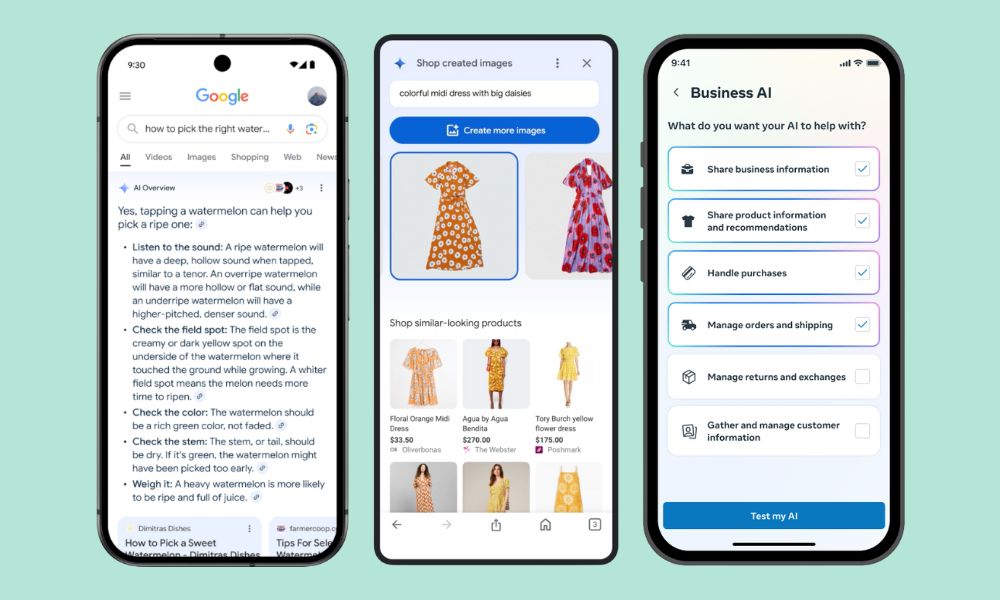Will these AI tools change how we all do business?

If it feels nearly impossible to keep up with all of the new AI updates and features, you’re not alone.
Most of us are just now getting comfortable working with ChatGPT, Claude, or Gemini, but we know there’s so much more out there.
That’s why we’re bringing you a rundown of the 3 new AI developments you need to know about this week:
1. Google Search is going full AI
SEO is the cornerstone of digital marketing. It’s how the majority of us get found, and as an industry we’ve poured an incredible amount of time and energy into optimizing our websites to appear at the top of search results.
Recently, we’ve started to see AI summaries at the top of Search Engine Results Pages (SERP) that attempt to give people quick, easy answers to their searches without ever having to click to a website. While that might be convenient for us as users, it’s terrible for content marketers because we’ve been investing in high quality content to try to earn traffic and, therefore, customers.
It looks like that’s just the beginning. Google is now testing a version of search results that not only offers an AI summary, but exclusively serves up AI-generated results. The SEO community is appropriately freaking out.
Google is telling us that driving traffic to websites is still central to their mission, but it’s hard to see how that can be true when the SERP removes any need for people to click.
If you’ve been working in digital marketing for a while, changes like this are all-too-familiar. You lived through the Facebook rug pull where they killed organic reach in favour of advertising, and you had to pivot your advertising strategy when Apple cut off tracking on their devices.
But this one could have the greatest impact yet, given that Google still controls nearly 90% of all online searches.
The good news is that, like every other shift, those who are paying attention can stay ahead of the curve. Plus, the same number of people will still need to find and buy products and services, so it will be on us to figure out the best ways to get in front of them.
Here are a few ideas:
- Social search is becoming one of the most popular ways to search, especially among young people. Make sure you can be found on Instagram, TikTok, and YouTube
- AI may not drive as much traffic, but you can still optimize for it to ensure that your website is being found by AI providers.
- Build direct channels. This one is the hardest, but most valuable. If you can build an audience that you own — either with email, a podcast, content creators, or other channel — then you will have a powerful hedge against AI search
Read more about Google’s shift to AI
2. Create, then buy with AI
Google also just announced a series of new AI shopping features, including an AI image generator that can create anything you can dream up, then find a version of it for you to buy.
The tool produces a series of AI-generated images based on the prompt, ie. “colourful midi dress with green daisies,” the user picks their favourite, and then Google goes out and finds a gallery of products that closely match their creation.
Other tools mentioned include a try-on generator that shows one clothing item on a variety of different body types; and a makeup filter that applies different styles to the shopper’s face, then finds the products they’ll need to create that look.
If people actually end up using these tools, it will fundamentally change the purpose of product business websites. Right now, most websites are built to help people shop, explore, and find new products, but in a world where people can search and find whatever they can imagine, that will no longer be necessary. Instead, product businesses will thrive if they can predict what people are most likely to generate, then optimize their product pages to be the link that gets associated with those results.
As with all new technology, the actual impact will depend on how much people actually use it, but it certainly seems likely that at least some percentage of online shopping is about to change.
Read more about Google’s new AI shopping features here
3. Meta’s giving everyone the chance to have AI customer support
By now, we’ve all have some frustrating experiences with AI chatbots that promise to do a whole lot more than they can actually deliver. Meta believes the issue is not due to a fault in the AI system itself, but rather a lack of customized training data, and they’re currently testing a chatbot to solve this problem.
The chatbot — currently being offered for free to select small businesses — is trained on the business’ entire history of posts, replies, and DMs. The goal is for the chatbot to learn about the business, including its style, tone, and how it typically answers customer inquiries. It can then use this information to provide relevant and consistent responses to future customer questions. The AI bot can also be used in advertising to answer questions in-feed.
In their announcement, Meta mentioned that large enterprises are able to pull ahead when it comes to AI support because they have the IT resources to build custom, well-trained AI tools, and this is an effort to close the gap with SMBs.
If history teaches us anything about Meta, it’s that if this new tool is successful, they will quickly pull it behind a paywall, and/or bundle it with advertising or other paid features (they are a business after all). So before we get too excited about a powerful, no-cost feature, it’s important to recognize that the free ride is likely to end soon after everyone starts to depend on it.


